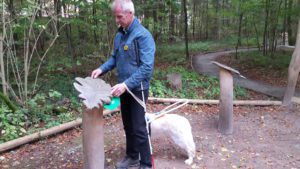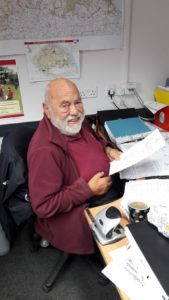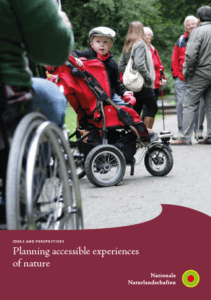Next EUROPARC Webinar: Accessibility and inclusion in Protected Areas
Contact with nature and enjoyment of the outdoors should be accessible experiences to every person. Protected Areas administrations play a fundamental role in providing opportunities to people with physical or intellectual disabilities, by creating accessible infrastructure for visitors and inclusive programmes and activities.
- 11th October 2018, 11:00 CEST (Central Europe Summer Time)
- Register here
Accessibility and inclusion in Protected Areas
From trail design to volunteering programmes
Several European Protected Areas are improving accessibility for visitors with reduced mobility, especially regarding accessible trail planning and design and barrier-free visitor centres, birdwatching hides or viewpoints. In some parks, there are also joelettes and other soft-mobility solutions available for visitors, and often, too, signage and communication tools are adapted to visually handicapped visitors or guests that are hindered by long, complicated texts.
Simultaneously, Parks strive for the inclusion of people with disabilities in the Park’s daily activities. Frequently, handicapped people are asked for technical advice on the planning of trails and infrastructure, and many have the opportunity to join special volunteering programmes for conservation work, supporting activities such as mowing meadows or repairing paths. In these cases, a strong cooperation between Park administrations and local social institutions or NGOs is fundamental for the implementation of volunteering programmes. By doing so, Parks not only have the chance to bring people closer to nature – they can provide life-changing experiences in their community, both for visitors and for the Park staff.
The secret of success lies in the attention you pay to each and every service you provide,
is an important recommendation from the manual “Planning Accessible Experiences of Nature”, produced by EUROPARC Germany. Although many parks might consider an expensive effort, according to EUROPARC Germany there are many ways, often easy and affordable, to improve the experience of disabled visitors. Observation and personal contact with visitors are fundamental, but also building up connections with local institutions, and exchanging experiences with other Parks, will certainly help you find new ways to improve accessibility and inclusion in your Park.
In this EUROPARC Webinar…
Anne Schierenberg and Kerstin Emonds from EUROPARC Germany will introduce us the manual “Planning Accessible Experiences of Nature”, and give us some hints on what you can do in your Park.
Our invited case study presenter from Germany will share examples of trail design and how they are developing volunteer programmes. Our invited guest from England will focus on the human dimension, explaining how the Park is working with long-term disabled volunteers and with a local senior residence, and also how they are building the capacity of the Park staff to work with volunteers with mental health issues.
Anne Schierenberg is the Head of Civil Engagement with EUROPARC Germany since 2003. Anne studied landscape planning at the Technical University of Berlin, graduating with a degree in engineering, and completed a voluntary ecological year at BUND Pfullendorf/Baden-Württemberg.
Kerstin Emonds is Officer for Accessibility and Inclusion with EUROPARC Germany since 2009. Kerstin also studied landscape planning at the Technical University of Berlin and after her qualification in regional management, she worked in this field for many years.
Case Study 1
Eichsfeld-Hainich-Werratal Nature Park: How we work together with people with disabilities
By Johannes Hager, Eichsfeld-Hainich-Werratal Nature Park, Germany

Tourist in the special trail for blind visitors at the Eichsfeld-Hainich-Werratal Nature Park, Germany – Photo by Uwe Mueller
The Eichsfeld-Hainich-Werratal Nature Park, located in the centre of Germany, promotes inclusion of people with disabilities in various manners. In the outdoor facilities of the information centre “Alter Wasserturm”, there is a path especially adapted for blind visitors, developed in cooperation with a regional NGO for visually handicapped people. In addition, the Park administration is currently evaluating and optimising their cycling routes in cooperation with a local handbike-user. The Park is also offering opportunities for volunteers with intellectual disability, to support the Park in practical conservation work.
Dr. Johannes Hager is the Director of the Eichsfeld-Hainich-Werratal Nature Park since 1992. Dr. Johannes Hager is Biologist with PhD in Ecology, having studied in Bonn, Innsbruck (Austria), Crete (Greece) and Bielefeld (Germany). Formerly, he worked as university assistant in Bielefeld, and as a consultant in Santo Domingo (Dominican Republic) in several projects related to wildlife and biodiversity protection.
Case Study 2
The Human Element – the involvement of people with disabilities in volunteering with the North York Moors National Park
By Ryan Chenery, North York Moors National Park, United Kingdom

Paul Hepworth is one of the volunteers who works in the Volunteering Administration department of the North York Moors National Park (UK). Paul gave an interview in which he talks about how much volunteering has changed him. Paul is physically disabled (spinal injury) and has kidney disease and therefore undergoes dialysis twice a week. Paul has been with the National Park for 1 year and volunteers 3 days a week every week!
The motivation of the North York Moors National Park to work with people with disabilities stems from one of their ten National Park Values – Promoting opportunities for everyone to get involved with the National Park. Indeed, the Park has a long history of working with volunteers with disabilities who contribute to both office and field work. Over the years, people have volunteered for a whole variety of reasons, but is becoming more common that people are volunteering due to health – including mental health. A number of Park staff said that volunteers want to talk about their mental health issues, but as staff felt ill-equipped to deal with this, the Park has trained 15 staff in mental health first aid this year, with a further 20 planned for September.
In addition to practical work out in the Park, the North York Moors is also engaging with disabled persons within their offices. They have 2 volunteers with disabilities participating in administrative roles in the Volunteering and IT Teams, who are both undertaking valuable work – and the opportunities have been created specifically to cater for their particular disabilities.
Ryan Chenery is the Volunteers Officer of the North York Moors National Park. Original from Barbados, Ryan moved to England in 2014 to work for RSPB and since 2017 he is responsible for overseeing the volunteer journey of every new Park volunteer – from recruitment and interview, to induction and training. Ryan also leads on the development and upskilling of volunteers and community involvement in volunteering across the National Park.
How to join?
Webinars are open not only to EUROPARC members – but to everyone with an interest in Protected Areas. Participation is free but registration is necessary.
You can join in from anywhere: you will just need a device with internet connection. EUROPARC webinars are held in English and last around 1:15 min. Participants have the chance to direct their questions to the invited speakers during the final discussion.

